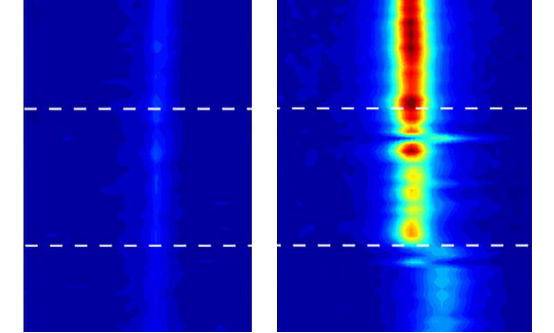
眾所周知,在海平面上,水的沸騰溫度是212華氏度,或100攝氏度。而且科學家們早就發(fā)現(xiàn),當水被存儲于非常小的空間內(nèi)時,它的沸點和冰點溫度會發(fā)生一點改變,通常會下降10攝氏度左右。
但現(xiàn)在,麻省理工學院的一個科研團隊發(fā)現(xiàn)了一系列意料之外的變化:在微小的空間里——在碳納米管中,它的內(nèi)部尺寸和幾個水分子的大小相當——水在非常高的溫度下(通常能夠讓它沸騰的溫度)卻凍結(jié)成了固體。
這個發(fā)現(xiàn)說明,當被限制在納米結(jié)構(gòu)中,即使是非常熟悉的材料也可能完全改變它們的行為。該發(fā)現(xiàn)可能會導致新的應用,如冰填充的電線,可以利用冰電線獨特的電和熱性能,因為這種‘冰’在室溫下能夠保持穩(wěn)定。
研究成果發(fā)表在今天出版的《自然納米技術》期刊上,論文作者是邁克爾 斯特拉諾,麻省理工學院化學工程教授卡本 P 杜布斯;博士后庫馬爾 阿格拉沃爾;和其他三位研究人員。
“如果你將流體限制在納米空間內(nèi),你可以完全改變它的相變行為,”斯特拉諾說,指的是如何及何時,物質(zhì)在固態(tài)、液態(tài)和氣態(tài)之間進行改變。這種變化是可預計的,但是這種巨大的改變和變化的方向(提高而不是降低冰點溫度)完全出乎意料:在該團隊的一次測試中,水的冰點溫度是105攝氏度或者更高(準確的溫度很難確定,但105攝氏度被認為是本次測試中的最低值;實際溫度可能高達151攝氏度。)
“這個結(jié)果出乎所有人的預料”斯特拉諾說。
事實證明,在微小的碳納米管中(完全由碳原子組成但直徑只有幾納米的蘇打水吸管的形狀),水的行為發(fā)生了改變——關鍵取決于納米管的直徑。“這是你能想到的最小管直徑,”斯特拉諾說。在實驗中,納米管的兩端是開放的,每一端都與儲水池連接。
研究人員發(fā)現(xiàn),1.05納米和1.06納米這點尺寸差別的納米管,都會出現(xiàn)幾十度的、明顯的冰點差異。“只是微小的改變,就讓一切變得不同,”斯特拉諾說。“這真是一個未知的空間。”
在之前的研究中,當被限制在如此小的空間內(nèi),了解水和其它流體的行為如何改變時,“一些模擬會出現(xiàn)矛盾的結(jié)果,”他說。其中一部分原因是,許多團隊沒有精確地測量碳納米管的尺寸,沒有意識到這種微小的尺寸差異可能會產(chǎn)生如此不同的結(jié)果。
實際上,水也會進入納米管中,這很令人驚訝,斯特拉諾說:碳納米管被認為是疏水性,因此水分子應當很難進入其內(nèi)部。但水確實能夠進入,這仍然是一個未解之謎,他說。
斯特拉諾和他的團隊利用高敏感度的成像系統(tǒng),利用振動光譜技術,跟蹤水在碳納米管中的運動,從而首次精準測量到了水的行為。
研究團隊不僅檢測到了水在碳納米管中的存在,而且也發(fā)現(xiàn)了它的相態(tài)變化,他說:“我們能夠判斷出它是氣態(tài)或液態(tài),我們也可以判斷它是否處于固態(tài)。”水進入固態(tài)的時候,該團隊沒有稱之為“冰”,因為這個詞意味著一種特定的晶體結(jié)構(gòu),水在納米管中還沒有呈現(xiàn)出這種狀態(tài)。“它不是真正的冰,而是與冰類似的相態(tài),”斯特拉諾說,在超過水的正常沸點溫度下,這種固態(tài)水也沒有融化,因此,在室溫條件下,它應該能夠保持穩(wěn)定。這種特性使得它具有廣闊的應用前景,他說。(張微/編譯)
以下為英文原文:
Researchers discover astonishing behavior of water confined in carbon nanotubes
It''s a well-known fact that water, at sea level, starts to boil at a temperature of 212 degrees Fahrenheit, or 100 degrees Celsius. And scientists have long observed that when water is confined in very small spaces, its boiling and freezing points can change a bit, usually dropping by around 10 C or so.
But now, a team at MIT has found a completely unexpected set of changes: Inside the tiniest of spaces—in carbon nanotubes whose inner dimensions are not much bigger than a few water molecules—water can freeze solid even at high temperatures that would normally set it boiling.
The discovery illustrates how even very familiar materials can drastically change their behavior when trapped inside structures measured in nanometers, or billionths of a meter. And the finding might lead to new applications—such as, essentially, ice-filled wires—that take advantage of the unique electrical and thermal properties of ice while remaining stable at room temperature.
The results are being reported today in the journal Nature Nanotechnology, in a paper by Michael Strano, the Carbon P. Dubbs Professor in Chemical Engineering at MIT; postdoc Kumar Agrawal; and three others.
"If you confine a fluid to a nanocavity, you can actually distort its phase behavior," Strano says, referring to how and when the substance changes between solid, liquid, and gas phases. Such effects were expected, but the enormous magnitude of the change, and its direction (raising rather than lowering the freezing point), were a complete surprise: In one of the team''s tests, the water solidified at a temperature of 105 C or more. (The exact temperature is hard to determine, but 105 C was considered the minimum value in this test; the actual temperature could have been as high as 151 C.)
"The effect is much greater than anyone had anticipated," Strano says.
It turns out that the way water''s behavior changes inside the tiny carbon nanotubes—structures the shape of a soda straw, made entirely of carbon atoms but only a few nanometers in diameter—depends crucially on the exact diameter of the tubes. "These are really the smallest pipes you could think of," Strano says. In the experiments, the nanotubes were left open at both ends, with reservoirs of water at each opening.
Even the difference between nanotubes 1.05 nanometers and 1.06 nanometers across made a difference of tens of degrees in the apparent freezing point, the researchers found. Such extreme differences were completely unexpected. "All bets are off when you get really small," Strano says. "It''s really an unexplored space."
In earlier efforts to understand how water and other fluids would behave when confined to such small spaces, "there were some simulations that showed really contradictory results," he says. Part of the reason for that is many teams weren''t able to measure the exact sizes of their carbon nanotubes so precisely, not realizing that such small differences could produce such different outcomes.
In fact, it''s surprising that water even enters into these tiny tubes in the first place, Strano says: Carbon nanotubes are thought to be hydrophobic, or water-repelling, so water molecules should have a hard time getting inside. The fact that they do gain entry remains a bit of a mystery, he says.
Strano and his team used highly sensitive imaging systems, using a technique called vibrational spectroscopy, that could track the movement of water inside the nanotubes, thus making its behavior subject to detailed measurement for the first time.
The team can detect not only the presence of water in the tube, but also its phase, he says: "We can tell if it''s vapor or liquid, and we can tell if it''s in a stiff phase." While the water definitely goes into a solid phase, the team avoids calling it "ice" because that term implies a certain kind of crystalline structure, which they haven''t yet been able to show conclusively exists in these confined spaces. "It''s not necessarily ice, but it''s an ice-like phase," Strano says.
Because this solid water doesn''t melt until well above the normal boiling point of water, it should remain perfectly stable indefinitely under room-temperature conditions. That makes it potentially a useful material for a variety of possible applications, he says.
